Advertisements
Advertisements
Question
Explain with a neat circuit diagram how will you determine unknown resistance ‘X' by using meter bridge
Solution
A Metre bridge consists of a wire of uniform cross-section and one metre in length, stretched on a metre scale which is fixed on a wooden table. The ends of the wire are fixed below two L shaped metallic strips. A single metallic stripe separates the two L shaped strips leaving two gaps, a left gap and a right gap.

Usually, an unknown resistance X is connected in the left gap and a resistance box is connected in the other gap. One terminal of a galvanometer is connected to terminal C on the central strip, while the other terminal of the galvanometer carries the jockey (J). Temporary contact with the wire AB can be established with the help of the jockey. A cell of emf (ε) along with a key (K) and a rheostat (Rh) is connected between points A and B.
A suitable resistance R is selected from the resistance box. The jockey is brought in contact with AB at various points on the wire AB and the balance point (null point), D, is obtained. The galvanometer shows no deflection when the jockey is at the balance point.
Let the respective lengths of the wire between A and D, and that between D and C be lx and lR. Then using the conditions for the balance, we get
`"X"/"R" = ("R"_"AD")/("R"_"DB")`
where RAD and RDB are resistance of the parts AD and DB of the wire resistance of the wire. If l is length of the wire, ρ its specific resistance, and A its area of cross section then
∴ `"R"_"AD" = (rho l_"AD")/"A"` and `"R"_"DB" = (rho l_"DB")/"A"`
∴ `"X"/"R" = "R"_"AD"/"R"_"DC" = (rho l_"x"//"A")/(rho l_"R"//"A")`
∴ `"X"/"R" = l_"x"/l_"R"`
∴ X = `l_"x"/l_"R" xx "R"`
Therefore R, lx and lR, the value of the unknown resistance can be determined.
APPEARS IN
RELATED QUESTIONS
Four resistances 4Ω,8Ω,XΩ, and 6Ω are connected in a series so as to form Wheatstone’s
network. If the network is balanced, find the value of ‘X’.
With the help of a labelled diagram, show that the balancing condition of a Wheatstone bridge is
`"R"_1/"R"_2 = "R"_3/"R"_4` where the terms have their usual meaning.
What should be the value of R in the figure for which the current in it is zero?
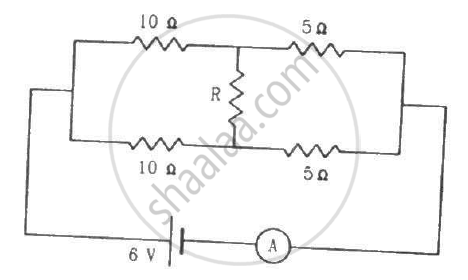
Obtain the balancing condition for the Wheatstone bridge arrangements as shown in Figure 4 below:

Choose the correct:
Four resistances 10 Ω, 10 Ω, 10 Ω and 15 Ω form a Wheatstone’s network. What shunt is required across 15 Ω resistor to balance the bridge
State any two sources of errors in the meter-bridge experiment. Explain how they can be minimized.
In a meter bridge, two unknown resistances R and S, when connected between the two gaps, give a null point is 60 cm from one end. What is the ratio of R and S?
Explain with a neat circuit diagram. How you will determine the unknown resistances using a meter bridge.
In a meter bridge, the balance point is found to be at 39.5 cm from the end A when the resistor R is 12.5 Ω (right gap).
a) Determine the resistance of X (left gap).
b) Determine the balance point of the bridge if X and R are interchanged?
c) What happens if the galvanometer and cell are interchanged at the balance point of the bridge?
In conversion of moving coil galvanometer into an ammeter of required range, the resistance of ammeter, so formed is ______.
[S = shunt and G = resistance of galvanometer]
In a Wheatstone bridge, when the potentials at points B and D are the same, then the current through the galvanometer ______
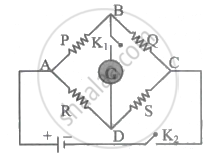
In a metre bridge experiment. the ratio of the left-gap resistance to right gap resistance is 2: 3. The balance point from the left is ______.
The metre bridge works on the principle of ______.
In the metre bridge experiment shown in the figure, the balance length AC corresponding to null deflection of the galvanometer is x. What would be the balance length if the radius of the wire AB is doubled?

On interchanging the resistances, the balance point of a metre bridge shifts to the left by 10 cm. The resistance of their series combination is 1 k`Omega`. How much was the resistance on the left slot before interchanging the resistances?
In Wheatstone's network p = 2 `Omega` , Q = 2 `Omega`, R = 2 `Omega` and S = 3 `Omega`. The resistance with which S is to be shunted in order that the bridge may be balanced is ______.
ln the metre bridge experiment, one metre long wire acts as ____________.
What is the e.m.f of the cell C in the circuit shown in figure, if the deflection in the galvanometer is zero, the resistance of the wire is 3 `Omega`, The length of the wire is 100 cm?
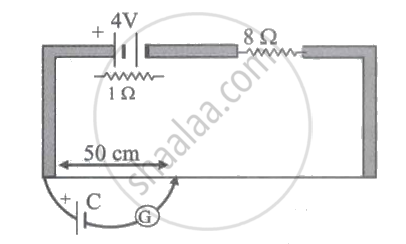
When the value of R in the balanced Wheatstone bridge, shown in the figure, is increased from 5 `Omega` to 7 `Omega`, the value of s has to be increased by 3 `Omega` in order to maintain the balance. What is the initial value of S?
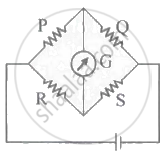
In the network shown cell E has internal resistance r and the galvanometer shows zero deflection. If the cell is replaced by a new cell of emf 2E and internal resistance 3r keeping everything else identical, then ______.
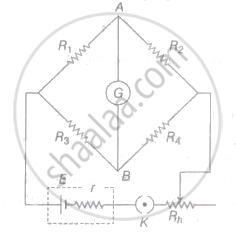
A resistance of 5 `Omega` is connected in the left gap of a metre bridge and 15 `Omega` in the other gap. The position of the balancing point is ____________.
The potential difference between the points A and B in the electric circuit shown is ______.

Which among the following resistances can be determined by a metre bridge?
In the measurement of a resistance by the Wheatstone bridge, the known and the unknown resistance are interchanged to eliminate ____________.
In the meter bridge experiment, the null point is obtained at a distance of ℓ from the left end. The resistance in the left and right gaps are halved and then interchanged. The new position of the null point is at ______
In a balanced metre bridge, 5 Ω is connected in the left gap and R Ω in the right gap. When R Ω is shunted with equal resistance, the new balance point is at 1.6 I1 where 'I1' is the earlier balancing length. The value of 'I1' is ______
In the meter bridge experiment, a null point was obtained at a distance of ℓ from the left end. The values of resistances in the left and right gaps are doubled and then interchanged. The new position of a null point is ______
In a meter bridge experiment, to minimize an error due to contact resistance, ______
ln, a Wheatstone network, P = Q = R = 8 `Omega` and S is 10 `Omega`. The required resistance to be connected to S so that network is balanced is ______.
When an unknown resistance 'X' is connected in the left gap of a meter bridge and a known resistance 'R' in the right gap, a null point is obtained at 40 cm from the left end. If a 2 Ω resistance is connected in series with 'X' the null point shifts towards the right by 10 cm, with some resistance in the right gap. The value of 'X' must be ______
The Wheatstone bridge is in a more balanced state when the ratio of arms P and Q is ______
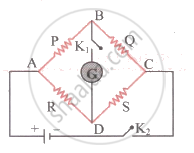
A resistance R is to be measured using a meter bridge. Student chooses the standard resistance S to be 100Ω. He finds the null point at l1 = 2.9 cm. He is told to attempt to improve the accuracy. Which of the following is a useful way?
The measurement of an unknown resistance R is to be carried out using Wheatstones bridge (figure). Two students perform an experiment in two ways. The first students takes R2 = 10 Ω and R1 = 5 Ω. The other student takes R2 = 1000 Ω and R1 = 500 Ω. In the standard arm, both take R3 = 5 Ω. Both find R = `R_2/R_1 R_3` = 10 Ω within errors.
- The errors of measurement of the two students are the same.
- Errors of measurement do depend on the accuracy with which R2 and R1 can be measured.
- If the student uses large values of R2 and R1, the currents through the arms will be feeble. This will make determination of null point accurately more difficult.
- Wheatstone bridge is a very accurate instrument and has no errors of measurement.
A resistance of 20 Ω is connected in the left gap of a meter bridge and an unknown resistance greater than 20 Ω is connected in the right gap. When these resistances are interchanged, the balance point shifts by 20 cm. The unknown resistance is ______.
In the given circuit, if I = 100 mA and I1 = I4 = 60 mA, the currents I3 and I5 are ______.
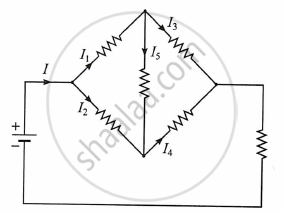
Explain the use of Wheatstone's metre bridge to determine an unknown resistance.
With an unknown resistance X in the left gap and a resistance of 30 Ω of the gap of a metre bridge, the null point is obtained at 40 cm from the left end of the wire. Find the unknown resistance. Also, find the shift in the null point when resistance in each gap is shunted by a resistance of 8 Ω.
Draw a neat labelled diagram to determine unknown resistance using a meter bridge.
Four resistances 4Ω, 4Ω, 4Ω and 12Ω form a Wheatstone's network. Find the resistance which when connected across the 12Ω resistance will balance the network.
What is a post office box? How is the· unknown resistance measured using a post office box?
In the given Wheatstone's network, what should be the value of R for the network to be balanced?
